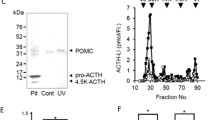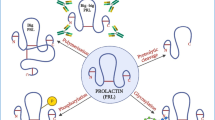Abstract
Placental protein/peptides as biological response modifier are well documented, but not much known about melanogenesis. We possibly for the first time, demonstrated melanogenesis in B16F10 mouse melanoma by a placental protein/peptide fraction (PPPF) prepared from a hydroalcoholic extract of fresh term human placenta. This study described the effect of PPPF on the induction of tyrosinase; the key enzyme of melanogenesis to investigate the basis of PPPF induced pigmentation in primary melanocyte and B16F10 melanoma. Tyrosinase induction by PPPF in B16F10 cells was found dose- and time dependent at the level of activity. Tyrosinase, at the level of transcription and protein expression when assessed by RT-PCR and Western blot analyses found to have considerable induction over untreated control. PPPF led to enhanced activation of tyrosinase promoter resulting higher transcription thus substantiating the role of PPPF as a stimulator of melanogenesis. Actinomycin D, the transcriptional inhibitor of protein synthesis, blocked the stimulatory action of PPPF since the induction of tyrosinase and melanin was markedly reduced in presence of this inhibitor. Thus the results suggested that PPPF mediated increase in tyrosinase expression occurred through transcriptional upregulation to stimulate melanogenesis in B16F10 cells and in primary melanocyte also. (Mol Cell Biochem xxx: 1–10, 2004)
Similar content being viewed by others
References
Tsatmali M, Ancans J, Thody AJ: Mealnocyte function and its control by melanocortin peptides. The Journal of Histochemistry & Cytochemistry 50(2): 125–133, 2002
Thody AJ: Skin pigmentation and its regulation. In: G.C. Priestley, (ed). Molecular aspects of Dermatology. West Sussex, UK: John Willey & Sons Ltd., 1993, pp. 55–73
Slominski A, Tobin DJ, Shibahara S, Wortsman J: Melanin pigmentation in mammalian skin and its hormonal regulation. Physiol Rev 84: 1155–1228, 2004
Hearing VJ, Tsukamoto K: Enzymatic control of pigmentation in mammals. FASEB J 5: 2902–2909, 1991
Korner AM, Pawelek JM: Mammalian tyrosinase catalyzes three reactions in the biosynthesis of melanin. Science 217: 1163–1165, 1982
Hearing VJ, Jiménez M: Mammalian tyrosinase: the critical regulatory control point in melanocyte pigmentation. Int J Biochem 19: 1141–1147, 1987
Kobayashi T, Urabe K, Winder A, Jiménez-Cervantes C, Imokawa G, Brewington T, Solano F, Garcia-Borron JC, Hearing VJ: Tyrosinase related protein 1 (TRP 1) functions as a DHICA oxidase in melanin biosynthesis. EMBO J 13: 5818–5825, 1994
Palumbo A, Solano F, Mishraca G, Aroca P, Garcia-Borron JC, Lozano JA, Prota G: Comparative action of dopachrome tautomerase and metal ions on the rearrangement of the dopachrome. Biochim Biophys Acta 1115: 1–5, 1991
Imokawa G, Yada Y, Kimura M: Siganlling mechanisms of endothelin-induced mitogenesis and melanogenesis in human melanocytes. Biochem J 314: 305–312, 1996
Abdel-Malek Z, Swope VB, Suzuki I, Akcali C, Harriger MD, Boyce ST, Urabe K, Hearing VJ: Mitogenic and melanogenic stimulation of normal human melanocytes by melanotropic peptides. Proc Natl Acad Sci USA 92: 1789–1793, 1995
Mcleod SD, Smith C, Mason RS: Stimulation of tyrosinase in human melanocytes by pro-opiomelanocortin-derived peptides. J Endocrinol 146: 439–447, 1995
Hunt G, Todd C, Kyne S, Thody AJ: ACTH stimulates melanogenesis in cultured human melanocytes. J Endocrinol 140: R1–R3, 1994
Hunt G, Todd C, Cresswell JE, Thody AJ: α-Melanocyte stimulating hormone and its analogue Nle4Dphe7α-MSH affect morphology, tyrosinase activity and melanogenesis in cultured human melanocytes. J Cell Sci 107: 205–211, 1994
Pawlek JM: Factors regulating growth and pigmentation of melanoma cells. J Invest Dermatol 66: 201–209, 1976
Seigrist W, Eberle A: In situ melanin assay for MSH using mouse B16 melanoma cells in culture. Anal Biochem 159: 191, 1986
Kauser S, Schallreuter KU, Thody AJ, Gummer C, Tobin DJ: Regulation of human epidermal biology by beta-endorphin. J Invest Dermatol 120: 1073–1080, 2003
Grigorakisi SI, Anastasiou E, Dai K, Souvatzoglou A, Alevizaki M: Three mRNA transcripts of the proopiomelanocortin gene in human placenta at term. Eur J Endocrinol 142: 533–536, 2000
Laatikainen T, Saijonmaa O, Salminen K, Wahlstorm T: Localization and concentrations of beta-endorphin and betalipotrophin in human placenta. Placenta 8: 381–386, 1987
Challis J, Matthews S, Van Meir C, Ramirez M: Current topic the placental corticotrophin-releasing hormone-adrenocorticotrophin axis. Placenta 16: 481–502, 1995
Fant EM, Nanu L: Human placental endothelin: expression of endothelin-1 mRNA by human placental fibroblast in culture. Molecular and Cellular Endocrinology 109: 119–123, 1995
Shams M, Ahmed A: Localization of mRNA for basic fibroblast growth factor in human placenta. Growth Factors 11: 105–111, 1994
Halaban R, Langdon R, Brichall N et al.: Basic fibroblast growth factor from human keratinocytes is a natural mitogen for melanocytes. J Cell Biol 107: 1611–1619, 1988
Pal P, Mallick S, Mandal SK et al.: A human placental extract: In vivo and in vitro assessments of its melanocyte growth and pigment inducing activities. Int J Dermatol 41: 760–767, 2002
Pal P, Roy R, Datta PK et al.: Hydroalcoholic human placental extract: skin pigmenting activity and gross chemical composition. Int J Dermatol 34: 61–66, 1995
Bhadra R, Pal P, Roy R, Dutta AK: Process for the preparation of an extract from human placenta containing glycosphingolipids and endothelin-like constituent peptides useful for the treatment of vitiligo. Indian patent appl. no. 1228/Del/94, 1994; US patent no. 5690966, 25 Nov. 1997; European Union patent appl. no. EP 0839535, 6 May 1998, Japanese patent pending.
Mandal SK, Mallick S, Dutta PK, Bhadra R: Mitogenic and melanogenic activity of human placental protein/peptides on melanoma cell. Curr Sci 78(12): 1552–1556, 2000
Mallick S, Singh SK, Sarkar C, Saha B, Bhadra R: Human placental lipid induces melanogenesis by increasing the expression of tyrosinase and its related protein in vitro. Pigment Cell Res 18(1): 25–33, 2005
Singh SK, Sarkar C, Mallick S, Saha B, Bera R, Bhadra R: Human placental lipid induces melanognesis through p38 MAPK in B16F10 mouse melanoma. Pigment Cell Res 18(2): 113–121, 2005
Eisinger M, Marko O: Selective proliferatrion of normal human melanocytes in vitro in the presence of phorbol ester and cholera toxin. Proc Natl Acad Sci USA 79: 2018–2022, 1982
Osborne JC Jr.: De-lipidation of Plasma lipoproteins: Methods in Enzymology, Vol 128, Academic Press Inc, New York, 1986, pp. 213–222
Lowry DH, Rosebrough NJ, Farr AL, Randall RJ: Protein measurement with folin-phenol reagent. J Biol Chem 193: 265–275, 1951
Nakazawa K, Sahuc F, Damour O, Collombel C, Nakazawa H: Regulatory effects of heat on normal human melanocyte growth and melanogenesis: comparative study with UVB. J Invest Dermatol 110: 972–977, 1998
Curto EV, Kwong C, Hermersdorfer H, Glatt H, Santis C, Virador V, Hearing VJ, Dooley TP: inhibitors of mammalian melanocyte tyrosinase: In vitro comparison of alkyl esters of gentisic acid with other putative inhibitors. Biochem Pharmacol 57: 663–672, 1999
Lammeli UK: Cleavage of structural proteins during the assembly of the head of bacteriophage T4. Nature 227: 680–685, 1970
Athanassiades, Lala PK: Role of placenta growth factor (PIGF) in human extravillous trophoblast proliferation, migration and invasiveness. Placenta 19(7): 465–473, 1998
Seppala M, Koistinen R, Rutanen EM: Uterine endocrinology and paracrinology: insulin-like growth factor binding protein-1 and placental protein 14 revisited. Human Reproduction 9: 917–925, 1994
Bowden SJ, Emly JF, Hughes SV, Powell G, Ahmed A, Whittle MJ, Ratcliffe JG, Ratcliffe WA: Parathyroid hormone-related protein in term placenta and membranes. J Endocrinol 142(2): 217–224, 1994
Eller MS, Yaar M, Gilchrest BA: DNA damage and melanogensis. Nature 372: 413–414, 1994
Author information
Authors and Affiliations
Corresponding author
Rights and permissions
About this article
Cite this article
Sarkar, C., Singh, S.K., Mandal, S.K. et al. Human placental protein/peptides stimulate melanin synthesis by enhancing tyrosinase gene expression. Mol Cell Biochem 285, 133–142 (2006). https://doi.org/10.1007/s11010-005-9069-3
Received:
Accepted:
Published:
Issue Date:
DOI: https://doi.org/10.1007/s11010-005-9069-3




